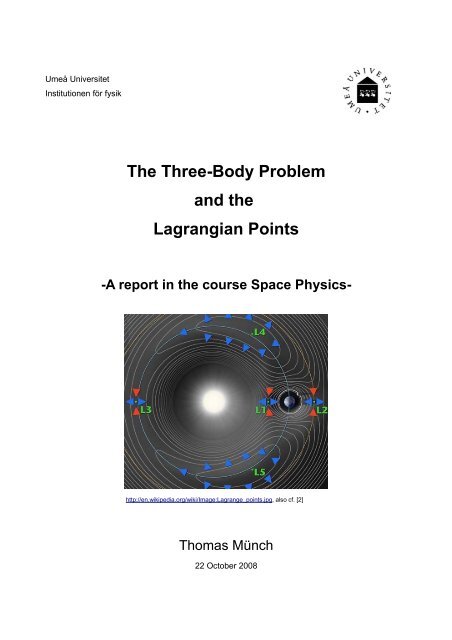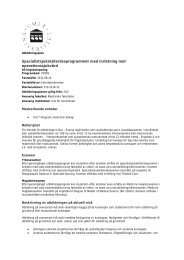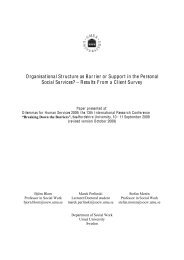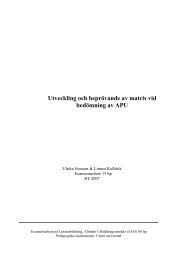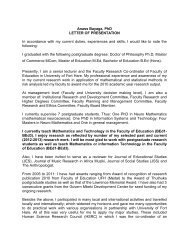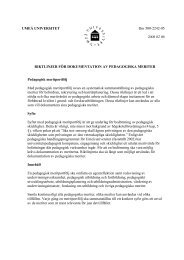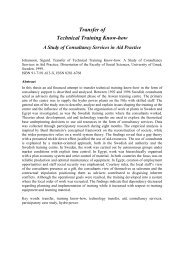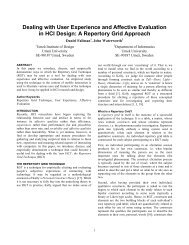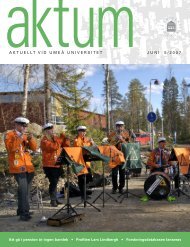The Three-Body Problem and the Lagrangian ... - Umeå universitet
The Three-Body Problem and the Lagrangian ... - Umeå universitet
The Three-Body Problem and the Lagrangian ... - Umeå universitet
Create successful ePaper yourself
Turn your PDF publications into a flip-book with our unique Google optimized e-Paper software.
Umeå Universitet<br />
Institutionen för fysik<br />
<strong>The</strong> <strong>Three</strong>-<strong>Body</strong> <strong>Problem</strong><br />
<strong>and</strong> <strong>the</strong><br />
<strong>Lagrangian</strong> Points<br />
-A report in <strong>the</strong> course Space Physicshttp://en.wikipedia.org/wiki/Image:Lagrange_points.jpg,<br />
also cf. [2]<br />
Thomas Münch<br />
22 October 2008
<strong>Three</strong> <strong>Body</strong>-<strong>Problem</strong> And <strong>Lagrangian</strong> Points – Thomas Münch<br />
Contents<br />
I Introduction.................................................................................................................................3<br />
II <strong>The</strong> Circular Restricted <strong>Three</strong>-<strong>Body</strong> <strong>Problem</strong>..........................................................................3<br />
II.1 Preliminary Remarks.............................................................................................................3<br />
II.2 <strong>The</strong> Two-<strong>Body</strong> <strong>Problem</strong>.........................................................................................................4<br />
II.3 Equations Of Motion.............................................................................................................5<br />
II.4 <strong>The</strong> <strong>Lagrangian</strong> Points..........................................................................................................6<br />
III Summary....................................................................................................................................9<br />
i
<strong>Three</strong> <strong>Body</strong>-<strong>Problem</strong> And <strong>Lagrangian</strong> Points – Thomas Münch<br />
I<br />
Introduction<br />
Space Physics may be defined as <strong>the</strong> region of <strong>the</strong> universe where astrophysical phenomena<br />
can be studied in situ, i.e., by direct measurements from spacecrafts or satellites. 1 From this it<br />
follows that in <strong>the</strong>se days <strong>the</strong> named region is limited to <strong>the</strong> Solar System.<br />
<strong>The</strong> Solar System, being <strong>the</strong> home for mankind in <strong>the</strong> universe, inhabits besides Earth seven<br />
more planets, a total of more than one hundred moons orbiting <strong>the</strong>se planets as well as some<br />
dwarf planets <strong>and</strong> an uncountable amount of asteroids. As being neutrally charged, all <strong>the</strong>se<br />
bodies only interact with one ano<strong>the</strong>r due to gravitational forces. Accordingly, from <strong>the</strong> point of<br />
Celestial Mechanics, determination of <strong>the</strong> trajectory of a given body would be impossible if one<br />
could not neglect <strong>the</strong> influences of almost all <strong>the</strong>se bodies on <strong>the</strong> given one as a result of <strong>the</strong><br />
nature of <strong>the</strong> gravitational force being proportional to <strong>the</strong> mass of <strong>and</strong> <strong>the</strong> inverse squared distance<br />
to <strong>the</strong>se bodies. To come full circle, such a given body can of course be a spacecraft or a satellite<br />
so that Celestial Mechanics is also an important topic in Space Physics.<br />
But never<strong>the</strong>less, <strong>the</strong> only analytically solvable problems in Celestial Mechanics are <strong>the</strong> twobody<br />
(Kepler's problem) <strong>and</strong> partly <strong>the</strong> circular restricted three-body problem. <strong>The</strong> last one shall<br />
now be <strong>the</strong> main topic in this report as nature offers us with it a great opportunity for satellite<br />
measurements by making use of <strong>the</strong> <strong>Lagrangian</strong> points.<br />
II<br />
<strong>The</strong> Circular Restricted <strong>Three</strong>-<strong>Body</strong> <strong>Problem</strong><br />
II.1<br />
Preliminary Remarks<br />
<strong>The</strong> three-body problem refers to three bodies which move under <strong>the</strong>ir mutual gravitational<br />
attraction. <strong>The</strong>re does not exist a general analytical solution to this problem but chaotic solutions<br />
<strong>and</strong> numerical ones based on iterative methods.<br />
If two of <strong>the</strong> three bodies move in circular <strong>and</strong> coplanar orbits around <strong>the</strong>ir common<br />
barycentre, <strong>and</strong> additionally, <strong>the</strong> third mass is small compared to <strong>the</strong> o<strong>the</strong>r two masses so that <strong>the</strong><br />
third body does not affect <strong>the</strong> movements of <strong>the</strong> o<strong>the</strong>r bodies one speaks of <strong>the</strong> circular restricted<br />
three-body problem. In this case <strong>the</strong> two big masses move on orbits which are determined by <strong>the</strong><br />
solution to <strong>the</strong> two-body problem <strong>and</strong> <strong>the</strong> remaining assignment is to make predictions for <strong>the</strong><br />
1 cf. Rönnmark, Kjell: Lecture Notes on Space Physics, p. 1.<br />
1
<strong>Three</strong> <strong>Body</strong>-<strong>Problem</strong> And <strong>Lagrangian</strong> Points – Thomas Münch<br />
trajectory of <strong>the</strong> third body being influenced by <strong>the</strong> gravitational field of <strong>the</strong> two big masses. This<br />
regime describes a good approximation for certain systems in our Solar System like a spacecraft in<br />
<strong>the</strong> gravitational field of Earth <strong>and</strong> <strong>the</strong> Sun or a space probe flying to Jupiter or Saturn being<br />
exposed to <strong>the</strong> gravitational attraction of <strong>the</strong> Sun <strong>and</strong> <strong>the</strong> planet. An analytical solution to <strong>the</strong><br />
behaviour of <strong>the</strong> third mass can be given in <strong>the</strong> case of equilibrium points (<strong>the</strong> <strong>Lagrangian</strong> points)<br />
<strong>and</strong> a description of <strong>the</strong> movement can be achieved as for example in <strong>the</strong> problem of <strong>the</strong> Hill<br />
sphere or <strong>the</strong> zero-velocity surfaces.<br />
II.2<br />
<strong>The</strong> Two-<strong>Body</strong> <strong>Problem</strong><br />
As some terms of <strong>the</strong> solution to <strong>the</strong> two-body problem are used in <strong>the</strong> discussion of <strong>the</strong><br />
circular restricted three-body problem a short overview of this solution shall be given here.<br />
With <strong>the</strong> definition<br />
:= G m 1<br />
m 2<br />
, (1)<br />
where G is <strong>the</strong> gravitation constant, m 1 <strong>and</strong> m 2 are <strong>the</strong> masses of <strong>the</strong> two bodies, respectively,<br />
Newton's second law for <strong>the</strong> two-body problem reads<br />
¨r = − r r 3 . (2)<br />
Note, that eq.(1) is <strong>the</strong> equation of motion for <strong>the</strong> vector r which denotes <strong>the</strong> relative position<br />
between <strong>the</strong> two bodies. This equation can be solved giving <strong>the</strong> modulus of <strong>the</strong> relative position<br />
depending on <strong>the</strong> polar angle φ,<br />
r = a1−e2 <br />
1e cos , (3)<br />
in which a is <strong>the</strong> semi-major axis <strong>and</strong> e <strong>the</strong> eccentricity of <strong>the</strong> elliptical orbit. By some<br />
manipulations of this equation <strong>and</strong> integration over one period 2 of <strong>the</strong> orbit you can determine <strong>the</strong><br />
frequency n of <strong>the</strong> orbit to<br />
n =<br />
a 3 . (4)<br />
This frequency is also referred to as <strong>the</strong> mean motion.<br />
2 cf. Murray, Dermott: Solar System Dynamics, pp.29-30 <strong>and</strong> [9].<br />
2
<strong>Three</strong> <strong>Body</strong>-<strong>Problem</strong> And <strong>Lagrangian</strong> Points – Thomas Münch<br />
II.3<br />
Equations Of Motion<br />
Let us consider a reference frame with its origin in <strong>the</strong> common centre of mass <strong>and</strong> <strong>the</strong> x-axis<br />
along <strong>the</strong> reference line of <strong>the</strong> two heavy bodies which rotates uniformly with <strong>the</strong> angular velocity n<br />
(<strong>the</strong> mean motion of <strong>the</strong> heavy bodies) around <strong>the</strong> z-axis. In this reference frame <strong>the</strong> positions of<br />
<strong>the</strong> two heavy masses remain fixed. With <strong>the</strong> assumption that m 1 > m 2 it is now convenient to<br />
rescale <strong>the</strong> unit of mass so that<br />
= G m 1<br />
m 2<br />
= 1 <strong>and</strong> to define<br />
:= m 2<br />
m 1 m 2<br />
. (5)<br />
Fur<strong>the</strong>rmore, we introduce 1<br />
:= G m 1 <strong>and</strong> <br />
2<br />
:= G m 2<br />
, or in <strong>the</strong> rescaled units<br />
1<br />
= 1<br />
= 1− <strong>and</strong><br />
2<br />
= , respectively. With a fur<strong>the</strong>r rescale of <strong>the</strong> unit of length so that<br />
a = 1 we see that 1<br />
2<br />
= a = 1 . Now we are able to adjust <strong>the</strong> coordinate system in such<br />
a way that <strong>the</strong> body m 1 has <strong>the</strong> coordinates (x,y,z) = (-μ 2,0,0) <strong>and</strong> <strong>the</strong> body m 2 <strong>the</strong> coordinates<br />
(x,y,z) = (μ 1,0,0).<br />
Fig.1. A planar view of <strong>the</strong> introduced reference frame for <strong>the</strong> circular<br />
restricted three-body problem<br />
<strong>The</strong> equations of motions in this reference frame for <strong>the</strong> light body at <strong>the</strong> position<br />
<strong>the</strong>n read<br />
r = x , y ,z<br />
ẍ−2 n ẏ−n 2 x = − 1<br />
x 2<br />
x− 1<br />
<br />
<br />
3 2 3<br />
r 1<br />
r , (6a)<br />
2<br />
ÿ2n ẋ−n 2 y = − 1<br />
r <br />
2<br />
3 3<br />
1 r y ,<br />
2<br />
(6b)<br />
3
<strong>Three</strong> <strong>Body</strong>-<strong>Problem</strong> And <strong>Lagrangian</strong> Points – Thomas Münch<br />
¨z = − 1<br />
r <br />
2<br />
3 3<br />
1 r z .<br />
2<br />
(6c)<br />
In this set of equations we see that <strong>the</strong>re is a force due to <strong>the</strong> gravitational field of <strong>the</strong> heavy<br />
masses on <strong>the</strong> right h<strong>and</strong> side. But <strong>the</strong>re are also terms on <strong>the</strong> left h<strong>and</strong> side which indicate <strong>the</strong><br />
centrifugal force being proportional to <strong>the</strong> squared mean motion <strong>and</strong> <strong>the</strong> force of <strong>the</strong> Coriolis effect<br />
which is proportional to <strong>the</strong> body's velocity <strong>and</strong> <strong>the</strong> mean motion. As a result of <strong>the</strong> Coriolis effect<br />
<strong>the</strong> movement of <strong>the</strong> light body in <strong>the</strong> plane of <strong>the</strong> heavy masses' orbits is coupled whereas <strong>the</strong><br />
movement in <strong>the</strong> z-direction decouples from <strong>the</strong> x- <strong>and</strong> y-direction.<br />
II.4<br />
<strong>The</strong> <strong>Lagrangian</strong> Points<br />
In order to be in an equilibrium position we have to dem<strong>and</strong> that <strong>the</strong> conditions<br />
ẍ = ÿ = ¨z = ẋ = ẏ = ż = 0 are simultaneously fulfilled, i.e., that all forces acting on <strong>the</strong> small<br />
body in <strong>the</strong> rotating frame of reference vanish. From this it is clear that <strong>the</strong>re cannot be a Coriolis<br />
force in an equilibrium position. So we have to look for points where <strong>the</strong> gravitational force <strong>and</strong> <strong>the</strong><br />
centrifugal force cancel each o<strong>the</strong>r. This can be done analytically, but as this would go beyond <strong>the</strong><br />
scope of this report we may be content with a qualitative analysis.<br />
By looking on <strong>the</strong> set of equations (6) we see that <strong>the</strong> condition ¨z = 0 can only be fulfilled for<br />
z = 0 so that <strong>the</strong> task of finding <strong>the</strong> equilibrium positions reduces to a planar problem. Fur<strong>the</strong>rmore,<br />
it follows that <strong>the</strong> centrifugal force acting on <strong>the</strong> light body always points radially outwards with<br />
respect to <strong>the</strong> common barycentre of <strong>the</strong> heavy masses. This makes us come to <strong>the</strong> conclusion<br />
that <strong>the</strong>re are only a few possible positions where <strong>the</strong> radially outwards pointing centrifugal force<br />
F Z can be cancelled by <strong>the</strong> gravitational forces F 1 <strong>and</strong> F 2 . Obviously, three of <strong>the</strong>m can<br />
be found on <strong>the</strong> reference line connecting <strong>the</strong> two masses m 1 <strong>and</strong> m 2 like it is depicted in fig.2.<br />
Fig.2. Positions of <strong>the</strong> <strong>Lagrangian</strong> points L 1, L 2 <strong>and</strong> L 3<br />
4
<strong>Three</strong> <strong>Body</strong>-<strong>Problem</strong> And <strong>Lagrangian</strong> Points – Thomas Münch<br />
On <strong>the</strong> one h<strong>and</strong> here <strong>the</strong> gravitational forces between <strong>the</strong> two major masses are directed in<br />
opposite directions <strong>and</strong> <strong>the</strong> total gravitational force at <strong>the</strong> first <strong>Lagrangian</strong> point L 1 is reduced in that<br />
way that it is oppositely equal to <strong>the</strong> centrifugal force. On <strong>the</strong> o<strong>the</strong>r h<strong>and</strong> <strong>the</strong>re are <strong>the</strong> <strong>Lagrangian</strong><br />
points L 2 <strong>and</strong> L 3 outside each major mass where <strong>the</strong> sum of <strong>the</strong> gravitational forces cancels <strong>the</strong><br />
centrifugal force. But now <strong>the</strong> symmetry of <strong>the</strong> problem suggests that <strong>the</strong>re have to be two more<br />
equilibrium points, each of <strong>the</strong>m building an equilateral triangle with <strong>the</strong> major bodies (see fig.3).<br />
<strong>The</strong>ir existence might not be seen offh<strong>and</strong> but <strong>the</strong>y are also found analytically.<br />
Fig.3. Positions of <strong>the</strong> <strong>Lagrangian</strong> points L 4 <strong>and</strong> L 5<br />
As already mentioned, <strong>the</strong>se qualitatively found <strong>Lagrangian</strong> points can also be derived<br />
analytically. Doing this one finds for <strong>the</strong> coordinates of <strong>the</strong> triangular points L 4 <strong>and</strong> L 5<br />
xL 4 /5<br />
= 1/2− 2<br />
; y L 4/ 5<br />
= ± 3<br />
2<br />
. (7)<br />
<strong>The</strong> x-coordinates of <strong>the</strong> remaining equilibrium points can be given in series,<br />
xL 1<br />
= 1<br />
− 1 3 2 1 9 3 23<br />
81 4 O 5 , (8a)<br />
xL 2<br />
= 1<br />
1 3 2 − 1 9 3 − 31<br />
81 4 O 5 , (8b)<br />
, (8c)<br />
xL 3<br />
= 1<br />
− 2− 7 12 7 12 2 − 13223<br />
20736 3 O 4<br />
5
where <strong>the</strong> parameters introduced are :=<br />
1/3<br />
2<br />
3 1<br />
<strong>Three</strong> <strong>Body</strong>-<strong>Problem</strong> And <strong>Lagrangian</strong> Points – Thomas Münch<br />
<strong>and</strong> := 2<br />
1<br />
, respectively; <strong>the</strong> y-<br />
coordinates are all equal to zero. Note, that all coordinates are still given in <strong>the</strong> rescaled length<br />
units – but to obtain <strong>the</strong> true values you simply need to multiply expressions (7) <strong>and</strong> (8) with <strong>the</strong><br />
“semi-major axis” a.<br />
An important topic which is always related to equilibrium positions is <strong>the</strong> question regarding <strong>the</strong><br />
stability of <strong>the</strong>se points. When asking for <strong>the</strong> linear stability of <strong>the</strong> <strong>Lagrangian</strong> points, i.e., putting<br />
<strong>the</strong> body in one of <strong>the</strong>se points <strong>and</strong> considering a small perturbation, you find that <strong>the</strong> <strong>Lagrangian</strong><br />
points L 1, L 2 <strong>and</strong> L 3 are not stable equilibrium positions. This means that no natural body will stay in<br />
<strong>the</strong>se points. But <strong>the</strong> triangular <strong>Lagrangian</strong> points are stable, provided, that <strong>the</strong> mass ratio of <strong>the</strong><br />
two heavy masses satisfies <strong>the</strong> condition<br />
m 1<br />
/m 2<br />
24.97 . A body positioned in one of <strong>the</strong>se two<br />
<strong>Lagrangian</strong> points which experiences a small perturbation will <strong>the</strong>n perform an oscillatory<br />
movement around <strong>the</strong> point. This is called libration <strong>and</strong> <strong>the</strong> resulting orbit in <strong>the</strong> co-rotating<br />
reference frame is referred to as an tadpole orbit. If <strong>the</strong> amplitude of this motion increases it can<br />
result in a movement which encloses both triangular <strong>Lagrangian</strong> points. One <strong>the</strong>n speaks of a<br />
horseshoe orbit.<br />
Fig.4. Tadpole orbits (on <strong>the</strong> left) <strong>and</strong> a horseshoe orbit (on <strong>the</strong> right) for a three-body<br />
system 3<br />
Due to <strong>the</strong> instability of <strong>the</strong> co-linear <strong>Lagrangian</strong> points no natural objects have been found at<br />
<strong>the</strong>se points in any three-body system until today. But <strong>the</strong>re are many examples for natural objects<br />
orbiting on or around (due to libration) <strong>the</strong> triangular <strong>Lagrangian</strong> points. <strong>The</strong> most famous of <strong>the</strong>se<br />
are <strong>the</strong> Trojan asteroids of Jupiter. An example of tadpole orbits are <strong>the</strong> small moons Telesto <strong>and</strong><br />
3 cf. [1].<br />
6
<strong>Three</strong> <strong>Body</strong>-<strong>Problem</strong> And <strong>Lagrangian</strong> Points – Thomas Münch<br />
Calypso orbiting L 4 <strong>and</strong> L 5, respectively, of <strong>the</strong> system consisting of Saturn <strong>and</strong> <strong>the</strong> bigger moon<br />
Tethys. <strong>The</strong> moons Janus <strong>and</strong> Epime<strong>the</strong>us are both on a horseshoe orbit in <strong>the</strong> Sun-Saturn<br />
system.<br />
Finally, I like to give two examples for <strong>the</strong> use of <strong>the</strong> <strong>Lagrangian</strong> points in Space <strong>and</strong><br />
Astrophysics.<br />
Currently <strong>the</strong> spacecraft SOHO (Solar <strong>and</strong> Heliospheric Observatory) is on a halo orbit around<br />
<strong>the</strong> <strong>Lagrangian</strong> point L 1 of <strong>the</strong> Sun-Earth system which is approximately 1.5·10 6 km away from<br />
Earth. It is not positioned exactly at L 1 as this would not be a stable position like discussed above<br />
<strong>and</strong> for some reason it would also complicate <strong>the</strong> communication with Earth. Never<strong>the</strong>less, <strong>the</strong><br />
halo orbit lies in <strong>the</strong> plane which passes through L 1 <strong>and</strong> is perpendicular to <strong>the</strong> reference line<br />
connecting Sun <strong>and</strong> Earth. <strong>The</strong>refore, due to <strong>the</strong> weak forces in this plane near to L 1, it does not<br />
need much fuel to keep <strong>the</strong> spacecraft in its orbit. Apparently, <strong>the</strong> second advantage is that <strong>the</strong><br />
spacecraft always stays at <strong>the</strong> same position relative to <strong>the</strong> Sun <strong>and</strong> Earth so that <strong>the</strong>re are no<br />
bigger objects disturbing <strong>the</strong> view onto <strong>the</strong> Sun. <strong>The</strong> three main scientific objectives of SOHO are<br />
to investigate <strong>the</strong> outer layer of <strong>the</strong> Sun, to make observations of <strong>the</strong> solar wind <strong>and</strong> to probe <strong>the</strong><br />
interior structure of <strong>the</strong> Sun. Besides that <strong>the</strong> spacecraft was able to detect many yet unknown<br />
comets which crossed <strong>the</strong> craft's field of view.<br />
<strong>The</strong> second example is <strong>the</strong> planned James Webb Space Telescope which will be positioned at<br />
<strong>the</strong> <strong>Lagrangian</strong> point L 2 of <strong>the</strong> Sun-Earth system. <strong>The</strong> telescope's main mission is to search for<br />
light from old stars <strong>and</strong> galaxies as well as to study <strong>and</strong> underst<strong>and</strong> <strong>the</strong> formation of galaxies,<br />
planetary systems <strong>and</strong> stars. Due to several effects <strong>the</strong> telescope has to operate at infrared<br />
wavelengths <strong>and</strong> accordingly has to be kept at a very low <strong>and</strong> stable temperature (about 40 K). At<br />
this point <strong>the</strong> usefulness of L 2 appears on <strong>the</strong> scene. For keeping <strong>the</strong> telescope at this low<br />
temperature a big metalized sunshield shall be used which blocks infrared radiation. But now <strong>the</strong><br />
position at L 2 ensures that <strong>the</strong> two main sources of infrared radiation, Sun <strong>and</strong> Earth, all <strong>the</strong> time<br />
occupy roughly <strong>the</strong> same relative position in <strong>the</strong> telescope's view which will make <strong>the</strong> use of <strong>the</strong><br />
sunshield most effective.<br />
III<br />
Summary<br />
We have seen that <strong>the</strong> three-body problem not only is a severe ma<strong>the</strong>matical problem, it also<br />
offers with <strong>the</strong> <strong>Lagrangian</strong> points an interesting <strong>and</strong> impressive insight on Celestial Mechanics as<br />
well as it plays an important role in modern research concerning Space <strong>and</strong> Astrophysics.<br />
7
<strong>Three</strong> <strong>Body</strong>-<strong>Problem</strong> And <strong>Lagrangian</strong> Points – Thomas Münch<br />
References<br />
[1] Internet source: GravitySimulator.com,<br />
http://www.orbitsimulator.com/gravity/articles/what.html.<br />
[2] Internet source: Image: Lagrange points.jpg,<br />
http://en.wikipedia.org/wiki/Image:Lagrange_points.jpg; original source:<br />
http://map.gsfc.nasa.gov/m_mm/ob_techorbit1.html, 31 March 2006.<br />
[3] Internet source: James Webb Space Telescope,<br />
http://de.wikipedia.org/wiki/James_Webb_Space_Telescope, 11 October 2008.<br />
[4] Internet source: James Webb Space Telescope,<br />
http://en.wikipedia.org/wiki/James_Webb_Space_Telescope, 11 October 2008.<br />
[5] Internet source: Lagrange-Punkt, http://de.wikipedia.org/wiki/Lagrange-Punkt,<br />
10 September 2008.<br />
[6] Internet source: SOHO, http://de.wikipedia.org/wiki/Solar_<strong>and</strong>_Heliospheric_Observatory,<br />
22 July 2008.<br />
[7] Internet source: SOHO, http://en.wikipedia.org/wiki/Solar_<strong>and</strong>_Heliospheric_Observatory,<br />
26 August 2008.<br />
[8] Murray, Carl D., Dermott, Stanley F.: Solar System Dynamics, Cambridge University Press,<br />
2000.<br />
[9] Münch, Thomas: Himmelsmechanik (Schmidt, Jürgen), private lecture notes, Universität<br />
Potsdam, Potsdam, 2008.<br />
[10] Rönnmark, Kjell: Lecture Notes on Space Physics. From <strong>the</strong> Sun to <strong>the</strong> Aurora, Umeå<br />
Universitet, Umeå, 15 August 2008.<br />
8


